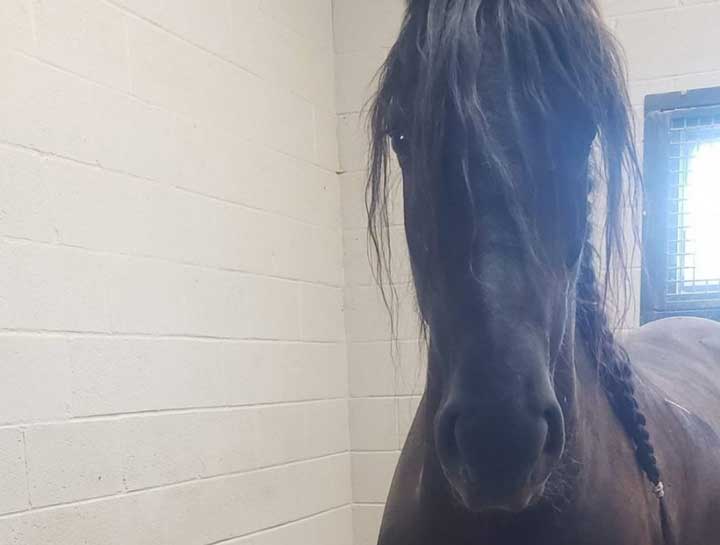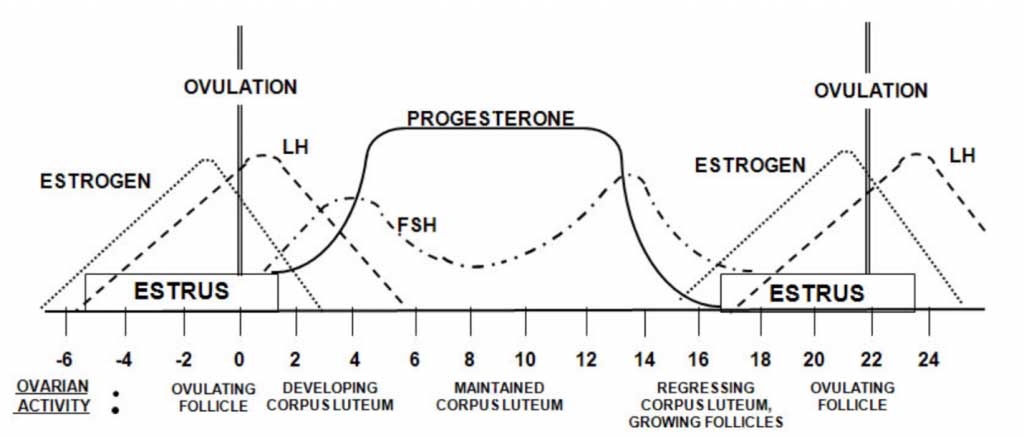Broodmare Basics

A happy and healthy pregnancy is exactly what any owner involved in breeding hopes for. The methods of getting a broodmare pregnant have evolved over the years moving to include not only live cover, but frozen and fresh cooled semen that is shipped worldwide. Keeping up with shipping schedules involves a solid base knowledge of the mare’s hormonal cycle; additionally, knowledge concerning manipulation of the cycle significantly increases the efficiency of the breeding process.
Cycle Overview: Hormones and Behavior

Figure 1: Hormone fluctuations of Equine Estrous Cycle. (Source: OK State extension)
The mare is seasonally polyestrous—meaning she will only be receptive to the stallion and ovulate during a specific time of year. In the Northern Hemisphere the mare begins cycling as the days in spring grow longer. Typically, most mares will naturally come into regular heat by mid-April and cycle regularly in approximately 21-day intervals until mid-September unless she becomes pregnant.
The estrous cycle contains two sections: estrus and diestrus (Figure 1). Estrus is the shorter of the two sections, lasting between 3 and 7 days, and is the time of the cycle where the mare will exhibit receptive behavior to a stallion. Blood levels of Estrogen and Luteinizing hormone (LH) are both rising during estrus; estrogen is the main hormone responsible for a mare’s receptivity to a stallion while LH is primarily responsible for ovulation. Diestrus is the time following ovulation until the beginning of the next heat. During this time an additional hormone—follicle stimulating hormone (FSH) rises and falls as the ovarian follicle develops. Diestrus also has elevated progesterone due to the presence of the corpus luteum which is formed following ovulation. Progesterone is also the hormone responsible for maintaining a pregnancy—initially from the corpus luteum and later from the placenta. By understanding how the hormones work to maintain the mare’s cycle it better enables owners and veterinarians to monitor their cycle.
Proper estrus detection is a vital aspect of any breeding program. Common practice includes serial ultrasound examination of a mare’s uterus and ovaries. During estrus the endometrial folds of the uterus become more edematous and can be characterized on a scale of 0 (nonexistent edema) to 3 (significant uterine edema). Serial ultrasounds of the ovaries can also identify growing and dominant follicles. By monitoring size of ovarian follicles, ideal breeding times can be determined, and post breeding checks can determine if/when the mare ovulates. Additionally, monitoring a mare’s behavior using a teaser stallion can help determine if a mare is in estrus. Typical estrus behavior involves raising their tail, squatting, urinating, and “winking” their vulvar lips. Some mares do not overtly exhibit this behavior however—some mares with foals at their side or a nervous or inexperienced mare may not exhibit estrus to the teaser and therefore ultrasound exam can provide more objective assessment of the mare’s cycle.
Artificial Light Program
One way to encourage a broodmare to begin cycling earlier than she would naturally come into season is by beginning an artificial light program—or—”putting her under lights.” Since the mare is a long day breeder, we can trick the mare’s body into coming into regular estrus by exposing her to an artificially increased day length. Exposure to 16 hours of light total, using a combination of natural daylight and artificial lights begun 30 minutes prior to sundown is the most effective way to encourage a mare to begin cycling early. Once begun, an artificial lighting program will take approximately 2-3 months to transition to normal cycling. The best option for maintaining consistency is by using an automatic timer for the lights. This eliminates depending on a person to turn lights on and off at appropriate times.
Hormonal Manipulation
In addition to a thorough understanding of the normal estrous cycle and manipulating the perceived photoperiod through artificial lighting, hormonal manipulation is a very useful tool when trying to meet appointments in the breeding schedule. The main hormone analogs used are prostaglandin (Cloprostenol), gonadotropin releasing hormone (deslorelin), and progesterone (altrenogest). Cloprostenol (Estrumate) is a hormone used to “short cycle” mares. Often called a heat shot, it causes a corpus luteum to regress and allows the mare to come into estrus 2-5 days following the intramuscular injection. To work effectively the corpus luteum must be 5-14 days old. A common hormone used to encourage ovulation of a dominant follicle (>35mm diameter) is deslorelin. This hormone works to induce ovulation within 48 hours of administration. When shipping semen for breeding this hormone can help push an ovulation to facilitate optimal breeding efficiency. Altrenogest (regumate) is also sometimes used to suppress a mare’s cycle if she is either in persistent estrus or is not cycling normally. As a synthetic version of progesterone, this hormonal manipulation will suppress the sexual behavior of estrus. When bringing a mare off of altrenogest, estrus will occur 4-5 days following cessation of treatment with ovulation occurring between 8-15 days. Altrenogest can also be used to help encourage pregnancy maintenance in mares that have trouble with early embryo loss.
By understanding multiple aspects of the mare’s cycle, we can effectively manipulate, maintain, and monitor the broodmare’s cycle. All this effort helps provide data to create a program for establishing a normal and healthy pregnancy that is adjustable for each broodmare’s needs.
Sources:
Sertich, Patricia L. November 2014. https://www.merckvetmanual.com/management-and-nutrition/management-of-reproduction-horses/reproductive-cycle-in-horses. Accessed 15 January 2021.
Giedt, Elisabeth, Hiney, Kris. June 2019. https://extension.okstate.edu/fact-sheets/reproductive-management-of-the-mare.html. Accessed 14 January 2021.
“Basic Broodmare Management.” Cooperative Extension Horses. 30 July 2020. https://horses.extension.org/basic-broodmare-management/. Accessed 14 January 2021.
